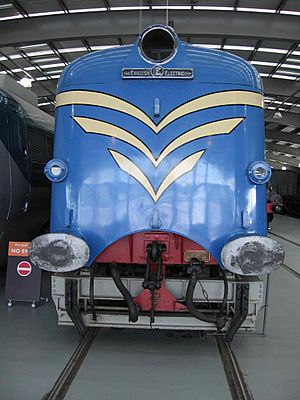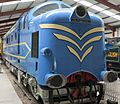British Rail DP1 facts for kids
Quick facts for kids English Electric DELTIC prototype |
|
 |
|
| The nose end of DP1 at Locomotion | |
| Power type | Diesel-electric |
|---|---|
| Builder | English Electric at Dick, Kerr Works, Preston |
| Serial number | EE: 2003 |
| Build date | 1955 |
| UIC classification | Co'Co' |
| Gauge | 4 ft 8 1⁄2 in (1,435 mm) |
| Wheel diameter | 3 ft 7 in (1.09 m) |
| Locomotive weight | 106 long tons (108 t) |
| Prime mover | Napier Deltic D18-25 (2 off) |
| Traction motors | EE 526/A, 6 off |
| Cylinders | 18 × 2 |
| Transmission | Diesel Electric |
| Top speed | 90 mph (140 km/h) 106 mph (171 km/h) from 1956 |
| Power output | 3,300 hp (2,500 kW) |
| Tractive effort | 90 mph gearing: 60,000 lbf (266.89 kN) 106 mph gearing: 52,500 lbf (233.53 kN) |
| Train heating | Stone-Vapor/Clarkson steam generator |
| Career | British Railways |
| Power class | Type 5 |
| Number | DP1 |
| Official name | DELTIC |
| Retired | March 1961 |
| Disposition | to Science Museum, London, April 1963 |
DP1, also known as the Prototype Deltic, was a super-powerful diesel-electric train engine. It was built by a company called English Electric in 1955. This special engine was like a test model for a new kind of train. It was so successful that the main railway company in Britain, British Rail, decided to order 22 more just like it! These new trains became known as the famous Class 55 locomotives.
Contents
What is a Prototype Locomotive?
A prototype is like the first version of something new. Think of it as a trial model. DP1 was built to show off a new type of engine and how well it could work. It helped engineers test new ideas before building many more trains.
The Amazing Deltic Engine
The name "Deltic" comes from the special engines inside DP1. It had two powerful Napier Deltic D18-25 engines. These engines were unique because they had 18 cylinders arranged in a triangle shape, like the Greek letter Delta. This design made them very powerful for their size.
How Powerful Was DP1?
DP1 was incredibly strong for its time. It could produce about 3,300 horsepower! This made it one of the most powerful diesel-electric locomotives in the world when it was built. It could pull heavy trains at high speeds.
Speed and Performance
When it was first built, DP1 could reach speeds of 90 miles per hour. Later, after some changes in 1956, it could go even faster, up to 106 miles per hour! This made it one of the fastest trains on British railways. Its power and speed helped it pull long passenger trains quickly.
DP1's Legacy
DP1 was a huge success. It showed British Rail that powerful diesel engines could replace older steam trains. Because of DP1's great performance, British Rail ordered 22 more Deltic locomotives. These new trains, the Class 55s, became famous for their speed and distinctive sound. They served for many years on main lines, especially between London and Scotland.
Where is DP1 Now?
DP1 stopped being used by British Rail in March 1961. It had done its job as a test engine. In April 1963, this important piece of railway history was moved to the Science Museum in London. You can still see it there today, a reminder of how train technology changed.
Images for kids
-
DP1 at the Ribble Steam Railway in 2015



